Capture of Malacca (1511)
The Capture of Malacca in 1511 occurred when the governor of Portuguese India Afonso de Albuquerque conquered the city of Malacca in 1511.
| Capture of Malacca | |||||||
|---|---|---|---|---|---|---|---|
| Part of Portuguese colonialism in Nusantara | |||||||
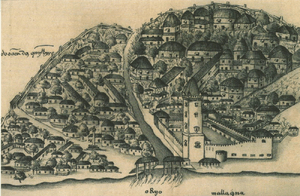 Portuguese drawing of Malacca in 1511, shortly after its conquest | |||||||
| |||||||
| Belligerents | |||||||
|
| Sultanate of Malacca | ||||||
| Commanders and leaders | |||||||
| Afonso de Albuquerque | Mahmud Shah | ||||||
| Strength | |||||||
|
700 Portuguese soldiers[3] 3 caravels 2 galleys[4] |
20,000 men[5] 2,000 or 3,000 artillery pieces[5] 20 elephants | ||||||
| Casualties and losses | |||||||
| Unknown[6] | Unknown | ||||||
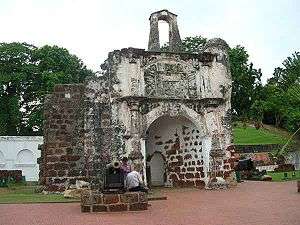
The port city of Malacca controlled the narrow, strategic Strait of Malacca, through which all seagoing trade between China and India was concentrated.[7] The capture of Malacca was the result of a plan by King Manuel I of Portugal, who since 1505 had intended to beat the Castilians to the Far-East, and Albuquerque's own project of establishing firm foundations for Portuguese India, alongside Hormuz, Goa and Aden, to ultimately control trade and thwart Muslim shipping in the Indian Ocean.[8]
Having set sail from Cochin in April 1511, the expedition would not have been able to turn around due to contrary monsoon winds. Had the enterprise failed, the Portuguese could not hope for reinforcements and would have been unable to return to their bases in India. It was the farthest territorial conquest in the history of mankind until then.[9]
Background
The first Portuguese references to Malacca appear after Vasco da Gama's return from his expedition to Calicut that opened a direct route to India around the Cape of Good Hope. It was described as a city that was 40 days' journey from India, where clove, nutmeg, porcelains and silks were sold, and was supposedly ruled by a sovereign who could gather 10,000 men for war and was Christian.[10] Since then, King Manuel had showed an interest in making contact with Malacca, believing it to be at, or at least close to, the antimeridian of Tordesillas.[11] In 1505 Dom Francisco de Almeida was dispatched by King Manuel I of Portugal as the first Viceroy of Portuguese India, tasked to, among other things, discover its precise location.
Dom Francisco, however, unable to dedicate resources to the enterprise, sent only two undercover Portuguese envoys in August 1506, Francisco Pereira and Estevão de Vilhena, aboard a Muslim merchant's ship. The mission was aborted once they were detected and nearly lynched on the Coromandel Coast, narrowly making it back to Cochin by November.[12]
City
Founded in the beginning of the 15th century, through Malacca passed all trade between China and India. As a result of its ideal position, the city harboured many communities of merchants which included Arabians, Persians, Turks, Armenians, Birmanese, Bengali, Siamese, Peguans and Lusong, the four most influential being the Muslim Gujaratis and Javanese, Hindus from the Coromandel Coast, and Chinese. According to the Portuguese apothecary Tomé Pires, who lived in Malacca between 1512 and 1514, as many as 84 dialects were spoken in Malacca.[13] The Portuguese factor Rui de Araújo said it had 10,000 homes, with an estimated population of at least 40,000.[14]
The city however was built on swampy grounds and surrounded by inhospitable tropical forest, and needed to import everything for its sustenance, such as vital rice, supplied by the Javanese.[15]
According to Brás de Albuquerque, the son of Afonso de Albuquerque:
The Kingdom of Malacca is confined on one part by the Kingdom of Kedah and on the other by the Kingdom of Pahang and is 100 leagues long in coastline and 10 leagues into the land to a mountain range which it parted with the Kingdom of Siam. All this land was once subject to the Kingdom of Siam until about ninety years prior (to the arrival of Afonso de Albuquerque to those parts) [...]
— Brás de Albuquerque, in Comentários do Grande Afonso de Albuquerque[16]
First contact with the Portuguese
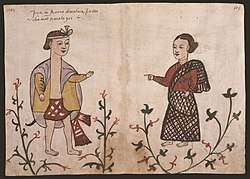
Unimpressed with Almeida's lack of results, in April 1508, King Manuel dispatched a fleet directly to Malacca, composed of four ships under the command of Diogo Lopes de Sequeira, who was also tasked with charting Madagascar and gathering information on the Chinese. Sequeira received royal orders specifically instructing him to obtain permission to open a trading post diplomatically and trade peacefully, not to respond to any provocations and not to open fire unless fired upon:
"We order and command that you should do no damage or harm at all parts you reach, and rather that all should receive honour, favour, hospitality and fair trade from you, for our service so demands it in these beginnings. And though something may be committed against you in your venture, and you might be in you right to cause harm, dissimulate it as best you can, showing that you wish not but peace and friendship, for we demand it of you. However should you be attacked, or deceived in such a manner that it may seem to you that they wished to do you harm, then you shall do all damage and harm as you can to those who sought to commit it against you, and in no other situation shall you do war or harm."
— Letter of King Manuel I of Portugal to Diogo Lopes de Sequeira, February 1508.[17]
By April 1509 the fleet was in Cochin and the Viceroy, Dom Francisco de Almeida, incorporated another carrack in the fleet to strengthen it. The decision was not entirely innocent, as aboard traveled several supporters of Almeida's political rival, Afonso de Albuquerque. Among its crewmen was also Ferdinand Magellan.[18]
The expedition arrived in Malacca in September 1509 and immediately Sequeira sought to contact the Chinese merchants in the harbor. They invited him aboard one of their trade junks and received him very well for dinner and arranged a meeting with Sultan Mahmud. The Sultan promptly granted the Portuguese authorization to establish a feitoria and provided a vacant building for that purpose. Wary of the threat that the Portuguese posed to their interests, however, the powerful merchant communities of Muslim Gujaratis and Javanese convinced Sultan Mahmud and the Bendahara to betray and capture the Portuguese.[19]
Sequeira in the meantime was so convinced of the Sultan's amiability that he disregarded the information that Duarte Fernandes, a New Christian who spoke Parsi, obtained from a Persian innkeeper about the ongoing preparations to destroy the fleet, confirmed even by the Chinese merchants.[20] He was playing chess aboard his flagship when the Malayan fleet, disguised as merchants, ambushed the Portuguese ships.[21] The Portuguese repelled every boarding attempt, but faced with the sheer number of Malayan ships and unable to land any forces to rescue those Portuguese who had stayed in the feitoria, de Sequeira made the decision to sail back to India before the monsoon started and left them completely stranded in Southeast Asia. Before departing he sent a message to the Sultan and the bendahara in the form of two captives each with an arrow through his skull as a testimony to what would happen to them should any harm come to the 20 Portuguese left behind, who surrendered.[21]
Preparations for the conquest
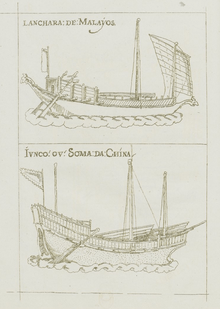
Upon reaching Travancore in April, Sequeira heard that Afonso de Albuquerque had succeeded Dom Francisco de Almeida as Governor of Portuguese India. Fearful of reprisals from Albuquerque for previously supporting Almeida, Sequeira promptly set sail back to Portugal.[21]
At that same time in Lisbon, King Manuel dispatched another smaller fleet under the command of Diogo de Vasconcelos to trade directly with Malacca, based on the assumption that de Sequeira had been successful in establishing commercial ties with the city. Vasconcelos arrived in Angediva Island in August 1510 where he found Governor Afonso de Albuquerque, resting his troops after failing to capture Goa some months before, and revealed his intentions of sailing to Malacca straight away. Albuquerque had in the meantime received messages from the captives at Malacca, written by the factor Rui de Araújo, and sent through envoys of the most powerful merchant of Malacca, a Hindu named Nina Chatu who interceded for the Portuguese. Araújo detailed the Sultan's military force, the strategic importance of Malacca as well as their atrocious captivity. Hence, Albuquerque was fully aware that for Vasconcelos to proceed to Malacca with such a meagre force was suicide, and managed to convince him to, reluctantly, aid him in capturing Goa later that year instead.[22]
With Goa firmly in Portuguese hands by December, Vasconcelos insisted that he be allowed to proceed to Malacca, which was denied. Vasconcelos mutinied and attempted to set sail against the Governor's orders, for which he was imprisoned and his pilots hanged.[23] Albuquerque assumed direct command of the expedition and in April departed from Cochin along with 1000 men and 18 ships.
Crossing of the Indian Ocean
During the passage to South-East Asia, the armada lost a galley and an old carrack. At Sumatra, the fleet rescued nine Portuguese prisoners who had managed to escape to the Kingdom of Pedir; they informed Albuquerque that the city was internally divided, and that the Bendahara (treasurer) had been recently assassinated. There they also intercepted several tradeships of the Sultanate of Gujarat, an enemy of the Portuguese.
Passing by Pacem the Portuguese came across a very large junk, larger in fact than even their flagship, the Flor do Mar. The Portuguese ordered it to halt but it promptly opened fire on the fleet, after which the Portuguese quickly followed suit. They realized however that their bombards were mostly ineffective: their cannonballs bounced off the hull of the junk. After two days of continuous bombardment though, the junk had its rudder destroyed, its masts felled, and most of its crew killed, and it surrendered. Once aboard, the Portuguese found a member of the royal family of Pacem, whom Albuquerque hoped he could exchange for the Portuguese prisoners.[24]
Portuguese conquest
_-_Autor_desconhecido.png)
By 1 July, the armada arrived at Malacca, salvoing their guns and displaying battle arrangements, which caused great commotion in the harbour. Albuquerque declared that no ship should set sail without his permission and immediately he tried to negotiate the safe return of the remaining prisoners still trapped in Malacca. As Albuquerque considered the Sultan's conduct to have been treasonous, he demanded that the prisoners be returned without a ransom as a token of good-faith, but Mahmud Shah replied with vague and evasive answers and insisted that Albuquerque sign a peace treaty beforehand. In reality, the Sultan was trying to buy time to fortify the city and call back the fleet, whose admiral the Portuguese identified as Lassemane (laksamana, literally, "admiral").
Albuquerque in the meantime kept receiving messages from the prisoner Rui de Araújo, who informed Albuquerque of the Sultan's military strength, through Nina Chatu. The Sultan could muster 20,000 men, which included Turkish and Persian bowmen, thousands of artillery pieces, and 20 war elephants, but he noted that the artillery was crude and lacking enough gunners. Albuquerque himself would later report to the King that only 4,000 of those were battle-ready.[25][26]
The Sultan on his part was not too intimidated by the small Portuguese contingent. Albuquerque would later write to King Manuel that, to his great consternation, the Sultan had somehow managed to correctly estimate the total number of soldiers aboard his fleet with a margin of error of "less than three men".[27] Thus, he remained in the city organizing its defence, "not realizing the great danger he was putting himself into".[28]
After weeks of stalled negotiations, by the middle of July the Portuguese bombarded the city. Startled, the Sultan promptly released the prisoners and Albuquerque then took the chance to further demand a heavy compensation: 300.000 cruzados and authorization to build a fortress wherever he wished. The Sultan refused. Presumably, Albuquerque had already anticipated the Sultan's response at that point. The Governor gathered his Captains and revealed that an assault would take place the following morning, 25 July, Day of Santiago.[29]
During the negotiations, Albuquerque was visited by representatives of several merchant communities, such as the Hindus, who expressed their support for the Portuguese. The Chinese offered to help in any way that they could. Albuquerque requested no more than several barges to help land the troops, saying that he did not wish the Chinese to suffer reprisals should the attack fail. He also invited them over to a galley to watch the fighting safely from afar, and authorized any who wished to leave to set sail from Malacca, which left the Chinese with a very good impression of the Portuguese.[18]
First assault
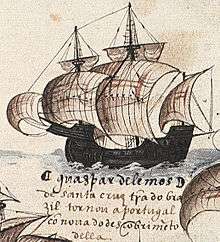
Albuquerque divided his forces in two groups, a smaller one under the command of Dom João de Lima and a larger one which he commanded personally. The landing commenced at 2 am. While the Portuguese fleet bombarded enemy positions on shore, the infantry rowed their boats onto the beaches on either side of the city's bridge. They immediately came under artillery fire from the Malayan stockades, though it was largely ineffective.[30]
Albuquerque landed his forces west of the bridge, known as Upeh, whereas Dom João de Lima landed on the east side, Ilher, where the Sultan's palace and a mosque were located. Once ashore, the Portuguese threw the barges' protective pavises on the sand to walk over the caltrops and gunpowder mines scattered all around.
Protected by steel helmets and breastplates, and with the fidalgos clad in full plate armour in the lead, the Portuguese charged the Malayan defensive positions, shattering any resistance almost immediately. With the stockades overcome, the squadron of Albuquerque pushed the defenders back to the main street and proceeded towards the bridge, where they faced stiff resistance and an attack from the rear.
On the east side, the squadron of Dom João faced a counter-attack by the royal corps of war elephants, commanded by the Sultan himself, his son Alauddin, and his son-in-law, the Sultan of Pahang. Briefly shaken, the Portuguese fidalgos raised their pikes and attacked the royal elephant, causing it to turn away in panic, scattering the other elephants and throwing the troops that followed into disarray. The Sultan fell from his elephant and was wounded, but managed to escape amidst the confusion.[31] By the middle of the day the two Portuguese groups had met at the bridge, surrounding the last defenders who jumped to the river where they were intercepted by Portuguese landing barge crews. With the bridge secure, the Portuguese raised canvas sheets to protect the exhausted infantry from the intense sun. The assault was called off however when Albuquerque came to realize how short on provisions they were, and ordered the troops to embark again, setting the royal palace and the mosque on fire along the way.
To prevent the Malays from retaking positions on the bridge, the following day the Portuguese seized a junk, armed it with artillery, which included fast firing breech-loading guns and very long pikes to prevent it from being rammed by incendiary rafts, and towed it towards the bridge. At the rivermouth, it ran aground and immediately came under heavy fire; its captain, António de Abreu, was shot in the face but was unrelenting of his post, declaring he would command the ship from his sickbed if necessary.[32]
Second assault
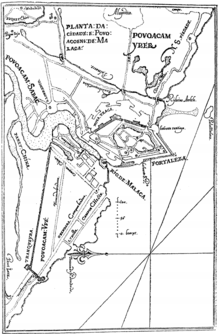
On 8 August, the Governor held a council with his captains in which he invoked the necessity to secure the city in order to sever the flow of spices towards Cairo and Mecca through Calicut and to prevent Islam from taking hold. For this assault, Albuquerque landed the entirety of his force, divided into three groups, on the western side of Malacca – Upeh – supported by a small caravel, a galley, and landing barges armed as gunboats. As the junk was dislodged by the rising morning tide, drawing the defenders' fire as it sailed towards the bridge, the landing began, while the armada bombarded the city. Once ashore, the Portuguese again quickly overcame Malayan defenses and recaptured the bridge, by then devoid of defenders. On either side the Portuguese set up barricades with barrels full of dirt, where they placed artillery. From the east side a squadron proceeded to assault the mosque, which again shattered the defenders after a drawn out struggle.[33]
With the bridge fortified and secured with enough provisions, Albuquerque ordered a few squadrons and several fidalgos to run through the streets and neutralize Malayan gun emplacements on the rooftops, cutting down any who resisted them, with the loss of many civilians.[32]
On 24 August, as the Sultan's resistance waned, Albuquerque decided to take full control of the city, commanding 400 men in ranks of 6 men wide through the streets, at the sound of drums and trumpets, eliminating any remaining pockets of resistance. According to Correia, the Malayans were greatly frightened by the Portuguese heavy pikes "which they had never seen before".[34]
The cleanup operation took 8 days. Unable to oppose the Portuguese any further, the Sultan gathered his royal treasure and what remained of his forces and finally retreated into the jungle.[35]
Sack
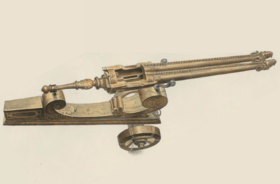
With the city secured, Albuquerque ordered the sack of Malacca, in the most orderly manner possible. For three days, from morning to nightfall, groups were given a limited time to run in turns to the city and return to the beach with whatever they could carry back. They were strictly forbidden from sacking the property of Chinese, Hindus, and Peguans, who had supported the Portuguese and were given flags to mark their households. The general population of Malacca was unharmed.[36] The plunder was immense: Over 200,000 cruzados reverted to the Crown along with 3,000 bronze and iron bombards and several slaves.[37] The cannons found were of various types: esmeril (1/4 to 1/2 pounder swivel gun,[38] probably refers to cetbang or lantaka), falconet (cast bronze swivel gun larger than the esmeril, 1 to 2 pounder,[38] probably refers to lela), and medium saker (long cannon or culverin between a six and a ten pounder, probably refers to meriam),[39] and bombard (short, fat, and heavy cannon).[40]:46 The Malays also has 1 beautiful large cannon sent by the king of Calicut.[40]:47[41]:22 Malay gunfounders were compared favourably with those of Germany, who were then the acknowledged leaders in the manufacture of firearms, and the Malay gun carriages were described as unrivalled by any other land, including Portugal.[39] The Portuguese also captured 3000 of the 5000 muskets which had been furnished from Java.[42]:96
According to Correia, regular soldiers received over 4,000 cruzados each, Captains received up to 30,000;[37] At the time, 1,000 cruzados was roughly the equivalent of the annual income of a Count in Portugal.[43] Albuquerque recovered from the expedition a stool incrusted with jewels, four golden lions and even a golden bracelet which was said to have the magical property of preventing the wearer from bleeding.[44] He estimated that two thirds of the wealth of the city remained.
Aftermath
The operation cost the Portuguese 28 dead, plus many more wounded. Despite the Sultan's impressive number of artillery pieces and firearms, they were largely ineffective. Most of the Portuguese casualties were caused by poisoned arrows.
The Sultan was evicted, but was not out of the fight. He retreated a few kilometers to the south of Malacca, to the mouth of the Muar River where he met up with the armada and set up camp, waiting for the Portuguese to abandon the city once they were done sacking it.
Fortress
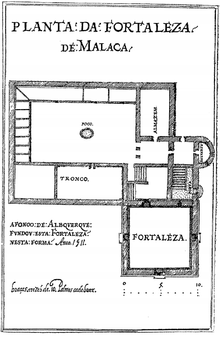
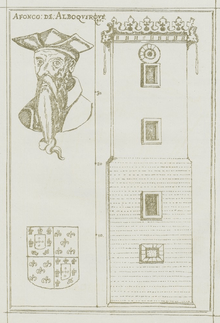
Contrary to the Sultan's hopes, Albuquerque did not wish to just sack the city, but to hold it permanently. To that effect he ordered the construction of a fortress close to the shoreline, which became known as A Famosa, due to its unusually tall keep, over eighteen meters high. Stone was brought in by ships as there wasn't enough in the city for its completion. It had a garrison of 500 men, 200 of which were dedicated to the service aboard the 10 ships left behind as the fortress' service fleet.[45]
Administration and diplomacy
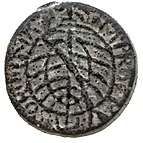
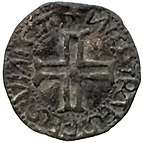
As hostilities ceased, Albuquerque immediately realized that the maintenance of such a distant city would depend greatly on the support the Portuguese could gather from the local population and the neighbouring polities. He assured the inhabitants that they would be able to proceed with their affairs as normally. Nina Chatu was nominated the new Bendahara of Malacca and representative of the Hindu community. The Javanese, Lusong and Malay communities also got their own magistrates (although the Javanese representative, Utimuta Raja, would be executed and replaced shortly after for conspiring with the exiled Sultan).[46] The trial of Utimuta Raja was the first act of justice the Portuguese carried out in Malacca according to Roman Law, with which "the people of Malacca was much relieved from that tyrant, and considered us folk of much justice"[47]
New currency was minted with the support of Nina Chatu and a parade was organized through the city streets, in which the new coins were thrown from silver bowls to the populace from atop eleven elephants. Two heralds proclaimed the new laws, one in Portuguese and another in Malay, followed by the Portuguese troops marching behind, playing trumpets and drums, "to great astonishment of the locals",[48] as Correia puts it.
Diplomatic missions were dispatched to Pegu and Siam to secure allies, as well as new suppliers of vital foodstuffs such as rice, to replace the Javanese, who were hostile to the Portuguese. Albuquerque had already sent an envoy, Duarte Fernandes, to Siam in July, while the assault on the city was still ongoing, and an exchange of diplomats secured the firm support of the King of Siam, who despised the Sultan of Malacca. The Kingdom of Pegu also confirmed its support for the Portuguese and in 1513 junks arrived from the Pegu to trade in Malacca.[49]
While he remained in the city, Albuquerque received envoys and ambassadors from many Malayan and Indonesian Kingdoms (which included even Sultan Mahmud's son-in-law, the Sultan of Pahang), with gifts dedicated to the King of Portugal.
The Portuguese recovered a large chart from a Javanese pilot, which according to Albuquerque displayed:
"...the Cape of Good Hope, Portugal and the land of Brazil, the Red Sea and the Sea of Persia, the Clove Islands, the navigation of the Chinese and the Gom, with their rhumbs and direct routes followed by the ships, and the hinterland, and how the kingdoms border on each other. It seems to me. Sir, that this was the best thing I have ever seen, and Your Highness will be very pleased to see it; it had the names in Javanese writing, but I had with me a Javanese who could read and write. I send this piece to Your Highness, which Francisco Rodrigues traced from the other, in which Your Highness can truly see where the Chinese and Gores come from, and the course your ships must take to the Clove Islands, and where the gold mines lie, and the islands of Java and Banda."
— Letter of Albuquerque to King Manuel I of Portugal, April 1512.[50]
Some of the information suggests adaptations had already been made based on Portuguese maps plundered from the feitoria in 1509. With such knowledge, the Portuguese learned the path to the fabled "Spice Islands", and in November, Albuquerque organized an expedition of three naus and 120 men to reach them, under the command of António de Abreu, who had previously been in the command of the junk. He was the first European to sail into the Pacific Ocean.[51]
When Albuquerque left Malacca in January 1512, the inhabitants mourned his departure.[52] Around the northwesternmost tip of Sumatra, the fleet faced a storm that wrecked Albuquerque's flagship, the Flor do Mar, with the loss of paperwork, an official letter from the King of Siam and the spoils and gifts intended for King Manuel, with the exception of a large rubi, a decorated sword and a golden goblet sent by the King of Siam which the crew managed to salvage.
In 1513, Jorge Álvares would set sail from Malacca and arrive in Canton, finally making contact with China.
Defence of Malacca and the fate of the Sultan
Shortly after Albuquerque's departure, the city suffered a harassment by the forces of the Sultan, but by then the Portuguese could count on over 500 men provided by the inhabitants of the city to assist them in repelling the attack.[53] In May, the Portuguese, along with over 2000 local allies under the command of Gaspar de Paiva, forced the Sultan out of his encampment by the Muar River.[54] The Sultan then retreated to the Pahang Sultanate, where he narrowly avoided an assassination attempt.[55] Afterwards, he moved to Bintan, an island-kingdom south-east of Singapore that he usurped to wage war on the Portuguese in Malacca, harassing the city, its trade and sabotaging their diplomatic relations with China, until the Portuguese eventually devastated Bintan in 1526, returning it to its rightful ruler and vassalizing the kingdom.[56] His son, Alauddin, would go on to found the Sultanate of Johor, and develop more or less pragmatical relations with the Portuguese.
Notes
- Bosworth, Clifford Edmund (2007). Historic cities of the Islamic world. BRILL. p. 317. ISBN 978-90-04-15388-2. Retrieved 23 August 2011.
- van Gent, Robert Harry. "Islamic–Western Calendar Converter". Universiteit Utrecht. Retrieved 23 August 2011.
- Cartas de Afonso de Albuquerque, Volume 1, pp. 396–397
- Cartas de Afonso de Albuquerque, Volume 1 p. 65
- Diffie, Winius, p. 256
- Diffie, Winius, p. 258
- The Cambridge History of the British Empire Arthur Percival Newton p. 11
- João Paulo de Oliveira e Costa, Vítor Luís Gaspar Rodrigues (2012) Campanhas de Afonso de Albuquerque: Conquista de Malaca, 1511 p. 13
- João Paulo de Oliveira e Costa, Vítor Luís Gaspar Rodrigues (2012) Campanhas de Afonso de Albuquerque: Conquista de Malaca, 1511 p. 7
- João Paulo de Oliveira e Costa, Vítor Luís Gaspar Rodrigues (2012) Campanhas de Afonso de Albuquerque: Conquista de Malaca, 1511 p. 13
- José Damião Rodrigues, Pedro Aires Oliveira (2014) História da Expansão e do Império Português ed. Esfera dos Livros
- João Paulo de Oliveira e Costa, Vítor Luís Gaspar Rodrigues (2012) Campanhas de Afonso de Albuquerque: Conquista de Malaca, 1511 p. 17
- Tomé Pires, Suma Oriental pp. 399, 422
- Luís Filipe F. Reis Thomaz (2000) Early Portuguese Malacca pp. 60–62
- Brás de Albuquerque, 1557 The commentaries of the great Afonso Dalboquerque, second viceroy of India, edited by Walter de Grey Birch, 1875, ch. XVIII pg. 87
- Brás de Albuquerque, 1557 Comentários do Grande Afonso de Albuquerque, edited by António Baião, 1923, part II ch. XVII
- In Portuguese: vos encomendamos e mandamos que em todas as partes omde chegardes naam façaees dano neem maal algum, antes todos de vos recebam homra, e favor, e guasalhado, e boom trauto, porque asy compre nestes começos por noso seruiço. E aimda que pella vemtura comtra vos se cometa allguma cousa, desymulallo-ees o melhor que poderdes, mostrande que aimda que teuesseis cauza e rezam pera fazerde dano, o lleixaes de fazer por asy vos mandado por nos, e nam quererdes senam paz e amizado peo, o armando sobre vos ou vos fazemdo allgum emgano tall que vos parecese que vos queriam desarmar, emtam faress a quem isto vos cometese todo o dano e mall que podeseis, e em outro caso nam farees nenhuma guerra nem mall - Raymundo António de Bulhão Pato (1884):Cartas de Affonso de Albuquerque, seguidas de documentos que as elucidam Lisbon, Typ. da Academia real das sciencias de Lisboa, p.417
- Fernão Lopes de Castanheda, 1552–1561 História do Descobrimento e Conquista da Índia pelos Portugueses edited by Manuel Lopes de Almeida, Porto, Lello & Irmão, 1979, book 2 ch. 106
- João Paulo de Oliveira e Costa, Vítor Luís Gaspar Rodrigues (2012) Campanhas de Afonso de Albuquerque: Conquista de Malaca, 1511 pp. 25–26
- Fernão Lopes de Castanheda, 1552–1561 História do Descobrimento e Conquista da Índia pelos Portugueses edited by Manuel Lopes de Almeida, Porto, Lello & Irmão, 1979, book 2 ch. 114
- João de Barros, 1553, Décadas da Ásia decade 2, book 4, ch. 4
- João Paulo de Oliveira e Costa, Vítor Luís Gaspar Rodrigues (2012) Campanhas de Afonso de Albuquerque: Conquista de Malaca, 1511 pp. 30–36
- João Paulo de Oliveira e Costa, Vítor Luís Gaspar Rodrigues (2012)Campanhas de Afonso de Albuquerque: Conquista de Goa (1510–1512)
- Gaspar Correia, Lendas da Índia Volume 2, p. 219
- Cartas de Afonso de Albuquerque, Volume 1 p. 37
- Fernão Lopes de Castanheda, 1552–1561 História do Descobrimento e Conquista da Índia pelos Portugueses edited by Manuel Lopes de Almeida, Porto, Lello & Irmão, 1979, book 3 ch. 52
- Raymundo Antonio de Bulhão Pato, Henrique Lopes de Mendonça (1884) Cartas de Afonso de Albuquerque, seguidas de documentos que a elucidam Academia das Ciências de Lisboa
- Brás de Albuquerque, 1557 Comentários do Grande Afonso de Albuquerque, edited by António Baião, 1923, part III ch. XX
- Gaspar Correia, Lendas da Índia Volume 2, p. 229
- João Paulo de Oliveira e Costa, Vítor Luís Gaspar Rodrigues (2012) Campanhas de Afonso de Albuquerque: Conquista de Malaca, 1511 p. 48
- Fernão Lopes de Castanheda, 1552–1561 História do Descobrimento e Conquista da Índia pelos Portugueses edited by Manuel Lopes de Almeida, Porto, Lello & Irmão, 1979, book 3 ch. 56
- Fernão Lopes de Castanheda, 1552–1561 História do Descobrimento e Conquista da Índia pelos Portugueses edited by Manuel Lopes de Almeida, Porto, Lello & Irmão, 1979, book 3 ch. 58
- Gaspar Correia, Lendas da Índia Volume 2, p. 235
- Gaspar Correia, Lendas da Índia Volume 2, p. 244
- João Paulo de Oliveira e Costa, Vítor Luís Gaspar Rodrigues (2012) Campanhas de Afonso de Albuquerque: Conquista de Malaca, 1511 p. 60
- Mansel Longworth Dames, 2016 The Book of Duarte Barbosa: An Account of the Countries Bordering on the Indian Ocean, Volume II p.179, Routledge
- Gaspar Correia, Lendas da Índia Volume 2, p. 248
- Manucy, Albert C. (1949). Artillery Through the Ages: A Short Illustrated History of the Cannon, Emphasizing Types Used in America. U.S. Department of the Interior Washington. p. 34.
- Lettera di Giovanni Da Empoli, with introduction and notes by A. Bausani, Rome, 1970, page 138.
- Charney, Michael (2004). Southeast Asian Warfare, 1300-1900. BRILL. ISBN 9789047406921.
- Crawfurd, John (1856). A Descriptive Dictionary of the Indian Islands and Adjacent Countries. Bradbury and Evans.
- Egerton, W. (1880). An Illustrated Handbook of Indian Arms. W.H. Allen.
- João Paulo de Oliveira e Costa, Vítor Luís Gaspar Rodrigues (2012) Campanhas de Afonso de Albuquerque: Conquista de Malaca, 1511 p. 61
- Brás de Albuquerque, 1557 Comentários do Grande Afonso de Albuquerque, edited by António Baião, 1923
- João Paulo de Oliveira e Costa, Vítor Luís Gaspar Rodrigues (2012) Campanhas de Afonso de Albuquerque: Conquista de Malaca, 1511 p. 65-69
- João Paulo de Oliveira e Costa, Vítor Luís Gaspar Rodrigues (2012) Campanhas de Afonso de Albuquerque: Conquista de Malaca, 1511 pp. 63-64
- "...foi aquela justiça a primeira que per nossas leis e ordenações, e processada segundo forma de Direito se fez naquela cidade. Com o qual feito o povo de Malaca ficou muito desassombrado daquele tirano, e houveram sermos gente de muita justiça... "João de Barros (1553) Década Segunda da Ásia de João de Barros, dos Feitos que os Portugueses fizeram no descobrimento & Conquista dos Mares e Terras do Oriente. 1988 edition, Imprensa Nacional Casa da Moeda, Lisbon, p. 6, 7
- Gaspar Correia, Lendas da Índia Volume 2, p. 257
- João Paulo de Oliveira e Costa, Vítor Luís Gaspar Rodrigues (2012) Campanhas de Afonso de Albuquerque: Conquista de Malaca, 1511 pp. 72-74
- Cartas de Afonso de Albuquerque, Volume 1, p. 64, April 1, 1512
- João Paulo de Oliveira e Costa, Vítor Luís Gaspar Rodrigues (2012) Campanhas de Afonso de Albuquerque: Conquista de Malaca, 1511 p. 74
- Fernão Lopes de Castanheda, 1552–1561 História do Descobrimento e Conquista da Índia pelos Portugueses edited by Manuel Lopes de Almeida, Porto, Lello & Irmão, 1979, book 3 ch. 131
- João Paulo de Oliveira e Costa, Vítor Luís Gaspar Rodrigues (2012) Campanhas de Afonso de Albuquerque: Conquista de Malaca, 1511 p. 79
- Saturnino Monteiro, 1989, Portuguese Sea Battles - Volume I - The First World Sea Power 1139–1521 p. 301
- Tomé Pires, Suma Oriental
- Saturnino Monteiro, 1989, Portuguese Sea Battles - Volume II - Christianity, Commerce and Corso 1522–1538
References
- Bailey W. Diffie, George D. Winius, Foundations of the Portuguese Empire, 1415–1580 (1977) ISBN 9780816608508

...